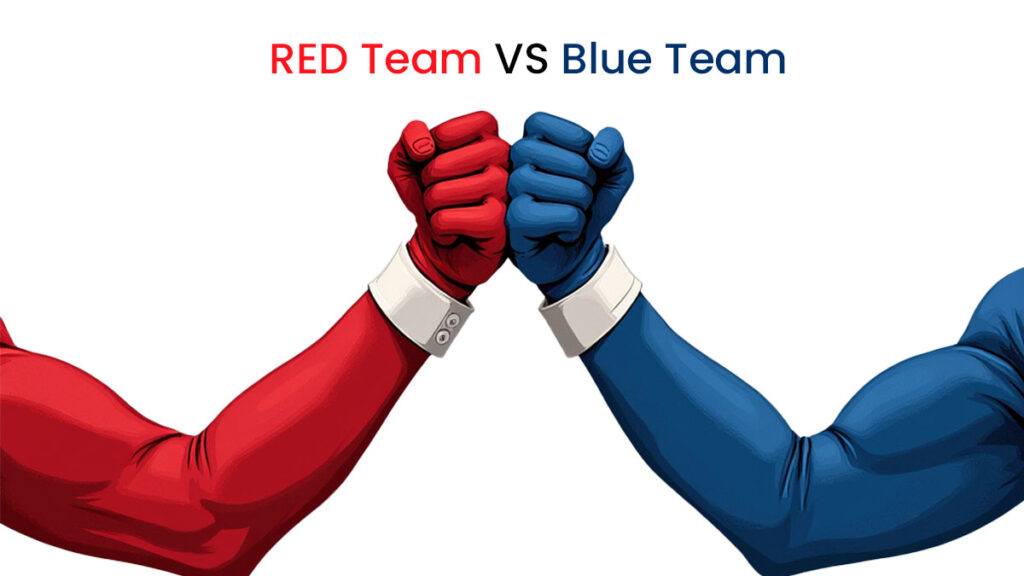In today’s fast-evolving threat landscape, cyberattacks are becoming more sophisticated and frequent. To stay ahead, organizations must not only build robust defenses but also rigorously test them. This is where the Red Team vs. Blue Team approach becomes essential.
Together, these two teams simulate attacks and defenses to identify weaknesses, strengthen security postures, and ensure resilience against real-world threats.
What is a Red Team?
The Red Team is composed of ethical hackers who simulate real-world cyberattacks. Acting as adversaries, they use the same tools and techniques that malicious actors might employ — but with one critical difference: their goal is to help, not harm.
By attempting to breach defenses, Red Teams expose vulnerabilities before real attackers can exploit them.
Key Objectives of a Red Team:
- Simulate realistic cyberattacks.
- Identify system and network vulnerabilities.
- Exploit weak spots to gain unauthorized access.
- Move laterally within systems to test deeper defenses.
- Extract sensitive data in a controlled environment.
In essence, Red Teams think like the enemy to build stronger defenses

What is a Blue Team?
The main line of defense for the company is the Blue Team. Working relentlessly to safeguard systems, data, and networks, their function is to track, identify, and react to threats in real time. The Blue Team works to improve security infrastructure and reduce risks even as the Red Team runs simulated assaults.
Core Responsibilities of a Blue Team:
- Continuous monitoring of networks and systems.
- Detecting and investigating suspicious activities.
- Responding swiftly to security incidents.
- Patching software vulnerabilities and closing security gaps.
- Conducting regular audits and security assessments.
- Training employees on cybersecurity best practices.
Simply put, the Blue Team keeps the digital fortress standing strong — day in and day out.
How Red and Blue Teams Work Together
Despite their contrasting roles, Red and Blue Teams collaborate closely. After an attack simulation:
- The Red Team provides detailed findings on exploited vulnerabilities.
- The Blue Team uses these insights to patch weaknesses and enhance defenses.
- Together, they create a feedback loop where every attack and response cycle leads to a stronger security posture.
This synergy ensures that cybersecurity isn’t static — it continuously evolves based on real-world learning
Why the Red vs. Blue Team Approach Matters
Implementing Red and Blue Team exercises is critical for organizations serious about cybersecurity. Here’s why:
- Identify Blind Spots: Discover vulnerabilities before hackers do.
- Improve Incident Response: Train teams to react faster and more effectively.
- Enhance Security Awareness: Educate employees through real-world simulations.
- Ensure Compliance: Meet regulatory standards with rigorous testing.
- Reduce Risk: Lower the chances of breaches and financial loss.
In today’s cyber environment, proactive defense is no longer a luxury — it’s a necessity

What is a Purple Team?
A Purple Team bridges the gap between Red and Blue. Instead of working independently, Purple Teams foster real-time collaboration:
- They ensure that Red Team findings are promptly shared with the Blue Team.
- They help Red Teams understand live defensive strategies.
- They coordinate attack-defense exercises for faster security improvements.
By enhancing communication, Purple Teams accelerate the evolution of organizational defenses
Essential Skills for Red and Blue Teams
Red Team Skills:
- Ethical hacking and penetration testing
- Exploit development and social engineering
- Malware simulation and adversary emulation
Blue Team Skills:
- Threat detection and incident response
- Log and traffic analysis
- SIEM operation and security hardening
Both roles demand a deep technical foundation and hands-on expertise
Challenges Faced by Red and Blue Teams

The Future of Red and Blue Teaming
As cyber threats evolve, Red vs. Blue Team exercises are becoming more sophisticated. Trends shaping the future include:
- AI-driven simulations and defenses: Automation helps simulate complex attacks and improve detection.
- Rise of Purple Teams: Hybrid teams are streamlining attack-defense collaboration.
- Continuous Testing: Cyber resilience now demands ongoing simulation, not occasional drills
Conclusion
The Red Team vs. Blue Team approach is more than a cybersecurity drill — it’s a critical strategy for organizations aiming to thrive in a digital-first world.
- Red Teams challenge the system.
- Blue Teams protect the system.
- Together, they uncover vulnerabilities, build stronger defenses, and prepare for real-world attacks.
If your organization is serious about cybersecurity, adopting this model isn’t optional — it’s essential




